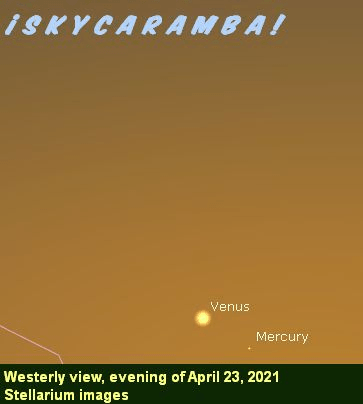Venus is an evening object again. But it remains a horizon hugger. Binoculars may help find it, but any obstruction on the horizon will spoil the view. It has a close pairing with Mercury on the 25th. They set just 35 minutes after sunset on that date from 18° north where they may be best seen. Very challenging viewing, indeed! Mercury gets a little easier to spot by the 30th.

As evening darkness sets in, the Hyades and Pleiades are setting. So is Orion.

Mars starts the month above them in the northernly region of Taurus and moves toward the feet of Gemini. The red planet will be near Tejat and Propus by the end of the month.
Leo is somewhat high in the west at sunset with Virgo and Boötes rising below it.

In the hours between midnight and dawn, watch Capricornus rising with Saturn in it and Jupiter nearly below at the beginning of the month. Mercury is even lower, rising below Aquarius close to sunrise.
The waning crescent moon passes by Saturn on the 6th and Jupiter on the 7th. Both planets are moving eastward. Jupiter is faster and has made it to Aquarius at month’s end. In the meantime, Mercury goes through superior conjunction on the 19th on the way to the aforementioned evening meeting with Venus. Mercury is at perihelion on the 27th.

Depending on where you are on April 2nd, a look at Jupiter in a telescope or good binoculars may show you the planet occulting a star. The star is 44 Capricorni, about 409 light years away. The occultation will be visible, at least in part, from much of eastern North America, most of Central America, and western South America. The farther north you are, the more likely you’ll get to see the beginning or the end but not both, because the sun is rising closer to the event time.If you’re not in the right place to see the star disappear or reappear, you may still want to look and see the star fitting in like it belongs among Jupiter’s moons. In Central America, you may even see Io reappearing after crossing Jupiter’s disk and occulting 44 Capricorni.
The moon is at southern lunistice at 25.4° and at last quarter on the 4th. It crosses the equator going north on the 11th, the day before it’s new. Northern lunistice at 25.5° is on the 18th, followed by first quarter phase two days later. The moon goes south again on the 25th and is full on the 27th. Apogee occurs on the 14th at 406,200 km. Perigee is on the 27th at 357,400 km. That perigee and full moon being on the same day mean a so-called supermoon.
The April Lyrids meteor shower peak is likely to be on the 22nd at 12 hours Universal Time. With the waxing gibbous moon, best viewing will be late evening to dawn for the western hemisphere.
People in Burma, Laos, Vietnam, Thailand, Cambodia, Malaysia, and part of Indonesia can see the moon pass in front of Mars on the 17th.
Uranus is in conjunction with the sun on the 30th.
